- How to Find the Best Toys for 3-Year-Olds - March 7, 2022
- How to Find the Best Toys for 12 Year Olds - February 28, 2022
- How to Find the Best Toys for 2 Year Olds - February 28, 2022
For kids, playtime is much more than just having fun. For many of them, it’s serious and they do their best to win those games or achieve the skills that the toy encourages them to improve. The most important thing in a toy is its safety. The second most important one is to suit the development stage or the age of the child.
Children have many emerging abilities and we must support those skills by offering them the proper toys. In today’s comprehensive guide, I will discuss the things you must consider when choosing age-appropriate toys for your little one, some of the best toy options on the market, and many other useful insights.
Age Appropriate Toys Guide – Choosing the Best Toys for Your Child Based on Age
Last year, when one of my nieces was one and a half years old, I gave her a toy made of wood. The word Montessori was on the label and I know that’s all the rage right now, so I went ahead to bought it for her. It was a fun yet educational set of some sort.
She looked and touched the toy for about 5 seconds before pulling it away and starting to play with a thread that was coming out of the bed cover. I was shocked to see how fascinated she was with that white simple string instead of looking and playing with her new colorful toys.
The point is to always pick something that will raise the interest of the child. Of course, sometimes, kids are drawn to things that apparently don’t make sense to adults, but that’s another story. Also, regardless of their age, kids develop and learn new things and abilities at their own personal pace, so you shouldn’t force it!

How Kids Play Based on Their Age
Let’s find out the way little kids play and the things that seem most appealing to them, based on their age.
How Babies Play
With babies, playtime is all about exploring their surroundings. The world is new to them, so they’re attracted to pretty much anything around them. They use all their senses to discover their environment.
That’s why they want to touch everything, to see if it’s sticky or not, smooth or rough, hard or soft, lightweight or hard, etc.
Babies tend to put things they find in their mouth or drop them on the floor to taste and fully experience a certain item. As your little one learns new motor skills, playtime also evolves into something more complex:
- At about 4-5 months old, a baby starts to grasp different objects that can easily fit in his or her tiny hands. They also tend to reach out for things a lot more than before;
- At around 6-7 months old, babies become able to transfer the objects they grasp between their hands;
- Once they’re 9 months old, their pincer grasp is fully developed, so it will be a lot easier for them to pick up objects from the floor. Obviously, we’re talking about small objects such as wooden toy blocks.
For babies, most of the play is considered an individual or solitary activity. At the same time, they can and will replicate the movements and play style of other babies if they all play side by side. From this stage, babies develop and go to the next one which is also known as the “how does this thing work?.”
How Toddlers Play
Toddlers are aware of the way things function. They start and enjoy placing blocks of wood on top of each other to create towers; others might begin to babble words into a toy phone. Pretend play begins during this growth stage. Your toddlers could try to make their doll fall asleep by tucking the toy into bed, or they could mimic sounds they’ve heard like choo-choo noises when they’re playing with a toy train.
All the skills toddlers learn now will become the solid foundation of the preschool type of play. Toddlers also begin to differentiate shapes and colors. So, the ideal toys for them should be colorful and very fun to hold. By the age of 2 years old, a child can scribble on a coloring book with a crayon, build towers made of toy blocks, and kick a football.
By the age of three years old, kids can pedal a tricycle and finish simple puzzles. Toddlers will master these new skills through a lot of repetition, so expect a lot of that.
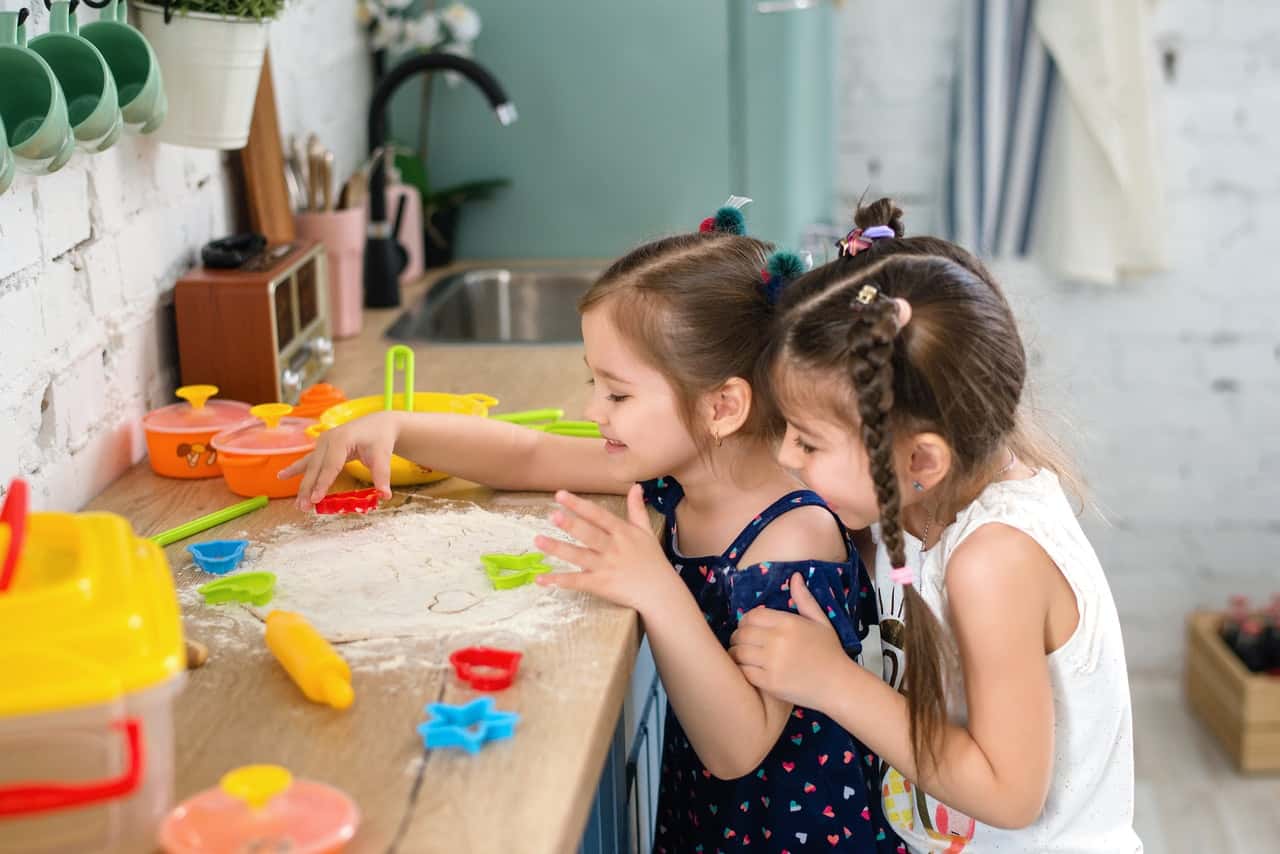
How Preschoolers Play
Preschoolers learn that every object they use has a specific purpose. So, they know that if they ring a bell, the purpose is to announce something or call for someone. Besides finding how things work and why they work the way they do, preschoolers are also very creative and imaginative, and they come up with all sorts of imaginary stories.
Encourage their creativity by asking them about the topic they’re discussing. They might even prepare you a meal from scratch, using their playdough and, in most situations, they want you to taste it and say how good it is. You should pretend to do that because that’s how you offer them your validation which further boosts their self-esteem.
For preschoolers, the world is full of possibilities and magical things can occur all the time. Some preschoolers might even believe they have magical powers, especially if they see these kinds of initiatives in cartoons or animations. I remember when I was about 5-6 years old, I used to believe that, at night, I can wake up and fly.
Those were dreams and in many of them, I was able to fly by going up on the roof and running till its edge. But, when I woke up the next day, I strongly believed I could actually fly and that the dream was real. It was a very confusing time! :))
Most preschoolers want their parents to get involved in their made-up fantasies, so make sure you dedicate enough quality time to your little fellow. You can even use these activities to help your child overcome anxiety and fears, and focus more on his or her dreams and hopes. Playtime becomes a lot more physical, and gadgets like electrical toy cars are highly popular among these kids.
How Bigger Kids Play
Elementary school-aged children have understood the way the world works around them, so they are looking for more challenging activities by going to the next level. They start to explore their hobbies and interests. For instance, a 5-6-year-old child who enjoys music might want to try playing the piano or any other musical instrument.
Around this period, children refine their fine and large motor skills. They have the courage to ride their bike without the safety wheels or they might want to try a skateboard for the very first time. Others might enjoy spending hours at a time crafting friendship bracelets or other fun DIY projects.
The relationships created with their peers become more important for them which means that your child might want to play with his or her friends and school colleagues rather than you. However, family playtime moments are still essential. So, make sure to plan at least one weekly game night where all the family members can participate.
TIP! Don’t forget that the most important “toy” for your child is you, spending time with his or her parents. Some moments are meant to be used as alone time or individual playtime, but your role is also important.
Besides individual play, kids should also play alongside their parents, painting together, reading stories, coloring, and doing many other types of fun and engaging activities.
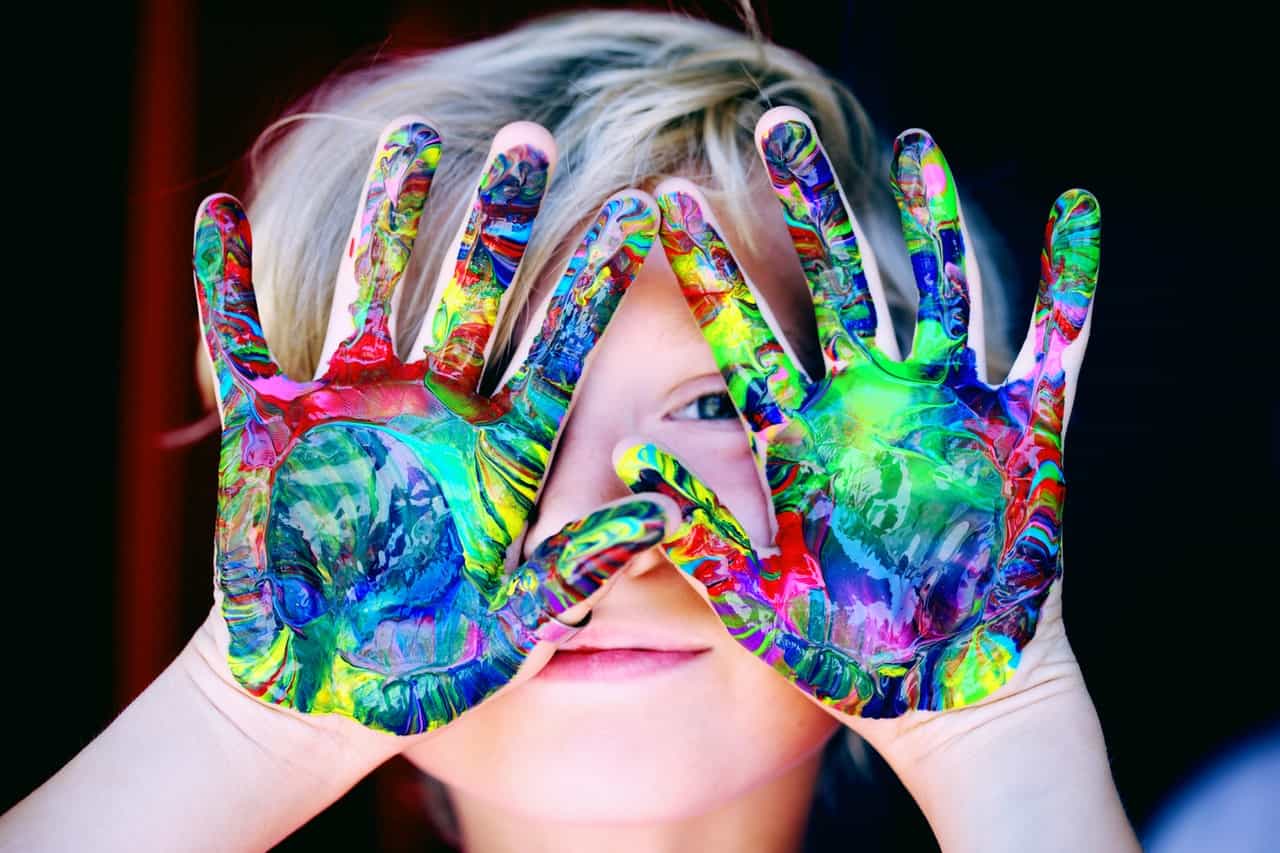
Toy Recommendations Based on Your Child’s Age
Young infants will certainly like toys that they can hold in their hands, put in their mouths, reach for, and create noise with. Babies love to follow with their eyes the way things move.
Older babies and toddlers love to move from one place to another to explore their surroundings and they understand simple words such as their names, body parts, and more.
Toddlers who’re as young as two years old start to comprehend the meaning of danger and their vocabulary improves. They can now control the things they do with their hands and fingers a lot better than before.
Preschoolers develop their attention span and they tend to be very curious, asking a lot of questions.
Toy Ideas for Infants
- Toys they can hold, reach for, safely put in their mouth, create noise with. Great ideas could be large silicone rings, teething toys, textured balls, squeeze toys, soft dolls, board and vinyl books, etc.;
- Toys they can listen to such as simple songs, lullabies recordings, and audiobooks with nursery poems;
- Things they can look at like unbreakable mirrors and pictures of faces.
Toy Ideas for Older Babies (7-12 Months Old)
- Play pretend toys like puppets, water toys, and wooden vehicles;
- Toys they can drop and lift from the ground such as large beads, nesting toys, plastic bowls, and balls;
- Things they can use to build different shapes with like wooden cubes or large soft blocks;
- Toys that can help muscle development such as push and pull toys and large balls.
Toy Ideas for Toddlers (1-2 Years Old)
- Illustrated board books;
- Non-toxic and washable markers and coloring crayons;
- Toy phones, stuffed toys, and dress-up accessories;
- Simple puzzles, cardboard blocks, and all sorts of balls;
- Construction sets, paintbrushes, child-sized kitchen furniture;
- Play-pretend child musical instruments;
- Hammering toys and balls.
Toy Ideas for Kindergartners and Preschoolers
- More complex puzzles, small colored blocks;
- Transportation toys;
- Accessorized dolls;
- Beach toy set, sand, and water plastic toys;
- Drawing and painting sets and books;
- Toy keyboards;
- Detailed picture books;
- Tricycles, balls, tunnels, child-appropriate computer educational games.
Age Appropriate Toys Guide – the Best Toys Based on Your Kid’s Age & Growth Stage
So far, I’ve presented you the skills that each development stage comes with and shortlists of generic toys that you could purchase. But, it’s now time to show you specific toys that you could consider for your child, based on his or her growth stage.
Toys for Babies (Between the Age of 3 and 18 Months Old)
Play Gym

Baby play gyms are a great idea as a present for a small baby. It’s a complex and versatile toy that can be used for a longer period since it comes with clear instructions and activity recommendations for different ages.
Buy one that can be converted into a tent because it will allow your child to play with it for a longer time.
Some brands will even offer subscription boxes for both babies and toddlers so that you can receive customized toys for every growth stage that your little one goes through.
Tiny Ticklers
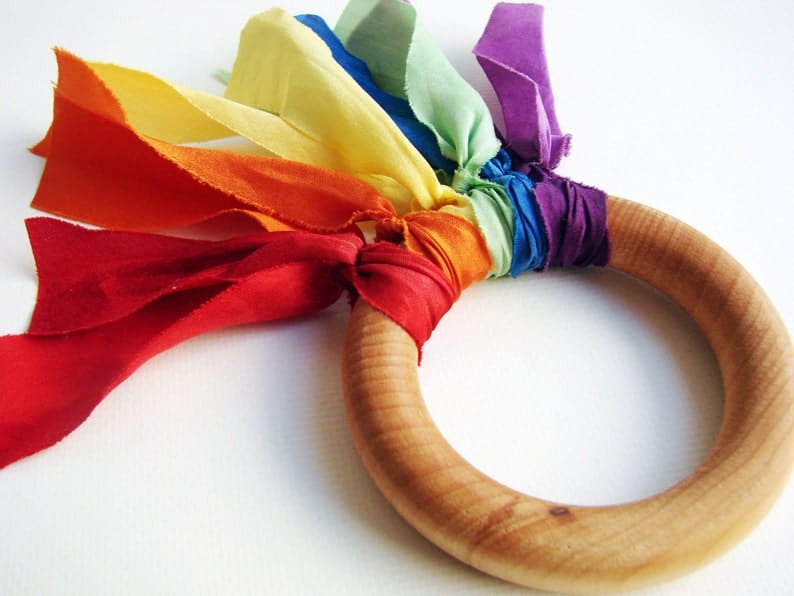
Another great idea is a Tiny Tickler wooden ring that your baby can easily hold and chew on. These toys will develop the baby’s visual skills due to their colorful design.
They also encourage the development of other skills including kinesthetic awareness, motor skills, visual tracking, and body curiosity.
These toys are inspired by two effective educational concepts: Waldorf and Montessori, and they’re sensory toys. The materials used to create these items are safe for children: wood, silk, and beeswax. The rings are handmade.
Toys for Toddlers (18 Months to 3 Years Old)
Little People Rainbow World
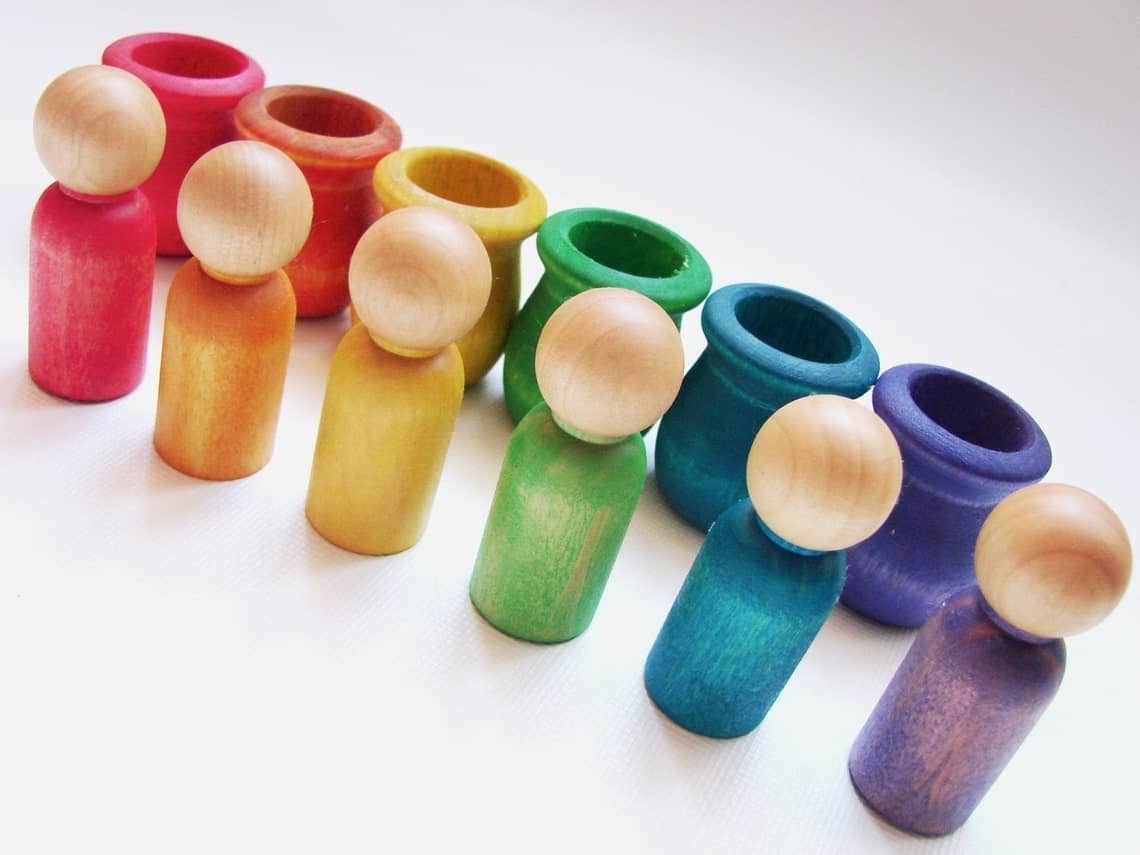
The Little People Rainbow World is a cute and colorful put-together puzzle consisting of paired wooden shapes. There are pawns and there are color-paired tiny wooden containers and your little one must match each pawn with the suitable container based on their color. I guarantee that your child will spend hours trying to figure this puzzle out.
It’s engaging and entertaining, while also being educational and inspired by two of the most effective concepts: Montessori and Waldorf. This toy is handmade and crafted with safe and non-toxic materials. Your little explorer will be delighted to play with it.
Wooden Matching Memory Game
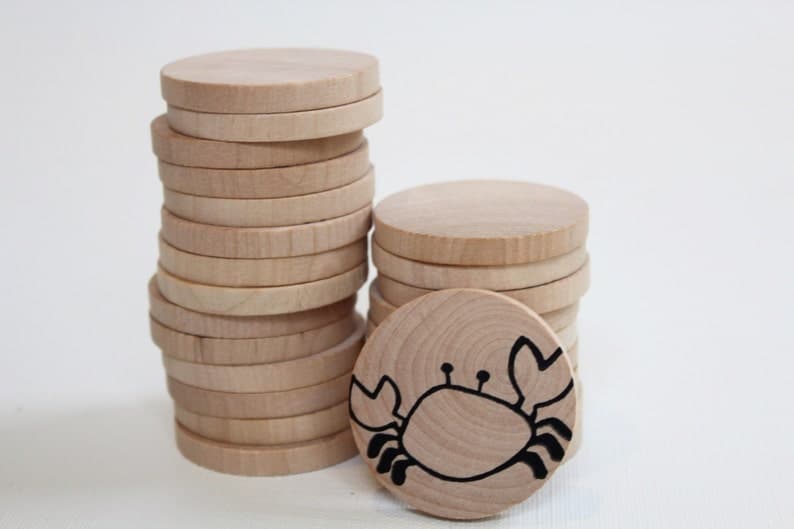
This wooden toy set is the ideal choice for any family game night. You can spend some quality time playing alongside your kids. Each wooden coin features an image of an animal or another nature-inspired element.
This wooden matching memory game will develop so many skills in your child. Each set comes with 24 pieces and the toy is portable so that you can take it with you when you’re going on holiday. It’s a great way to support the development of your baby’s memory.
Besides this beachy-inspired theme, you can also pick from other drawings as well, based on your kid’s preferences and interests: dinosaurs, musical instruments (I would have totally loved to play with this as a child), people’s faces, vehicles, and more.
Organic Cotton Play Tunnel
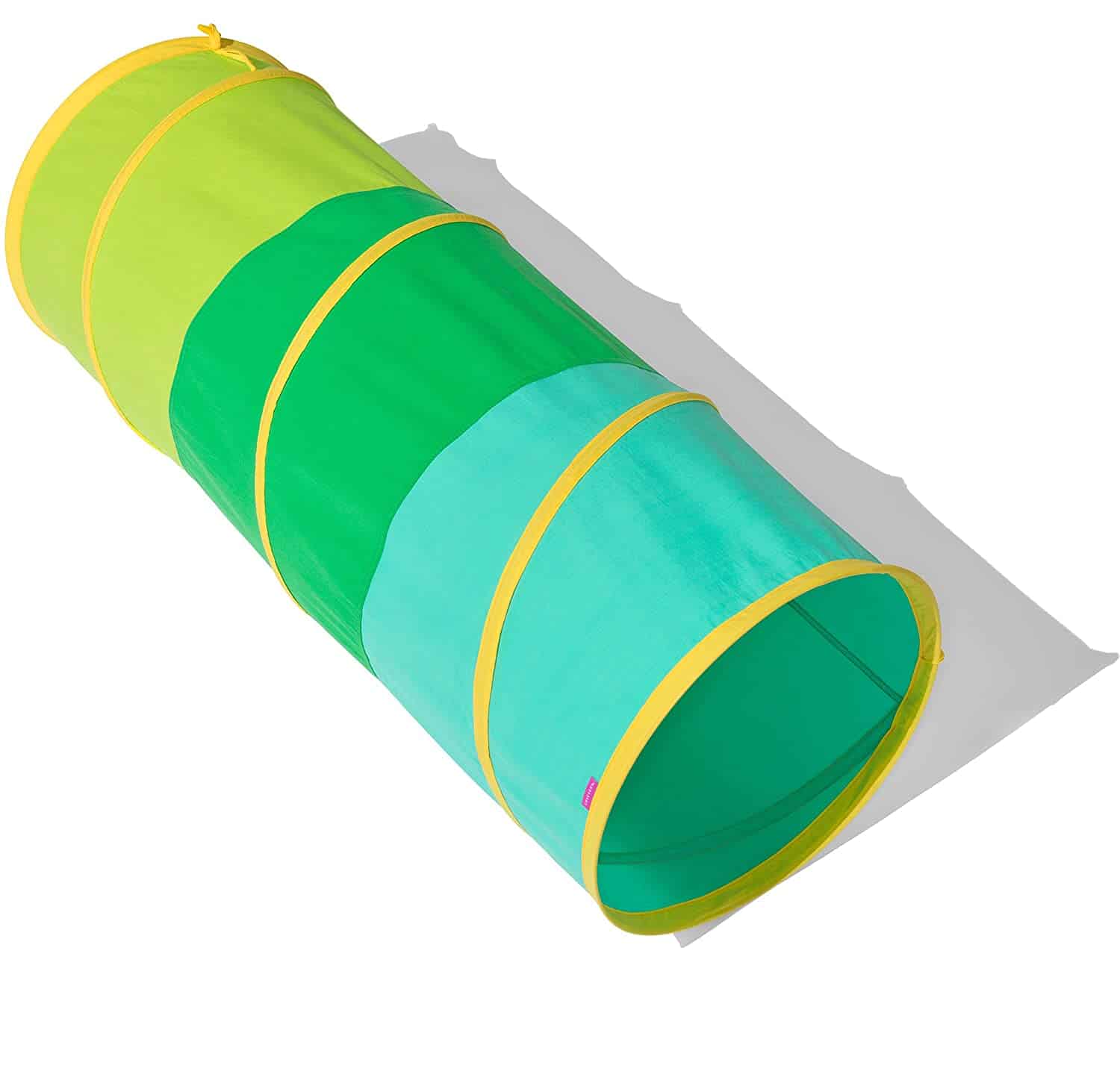
My niece loves to play hide-and-seek because she loves to crawl into tiny spaces and in all the corners of the house. I remember I also used to love doing that as a child because I imagined myself to be an explorer and every unexplored corner of the house used to intrigue and fascinate me. So, this play tunnel made of organic cotton is a way to start.
These sorts of toys will develop your little one’s motor skills, body balance, strength, walking, and coordination. All the materials used to create this tunnel are baby-safe.
Toys for Preschoolers (Between the Age of 3 and 5 Years Old)
Wooden People Play Set
This beautifully-crafted wooden set features all the members of a family in simple yet striking figures. All the figurines are delivered in a small box and include the parents and 4 children, each with its own colorful tiny blanket.
This is a creative toy that encourages kids to play pretend and imagine all kinds of family scenarios. Each figurine has a color on its bottom part that matches a certain blanket.
Lacing Hedgehog
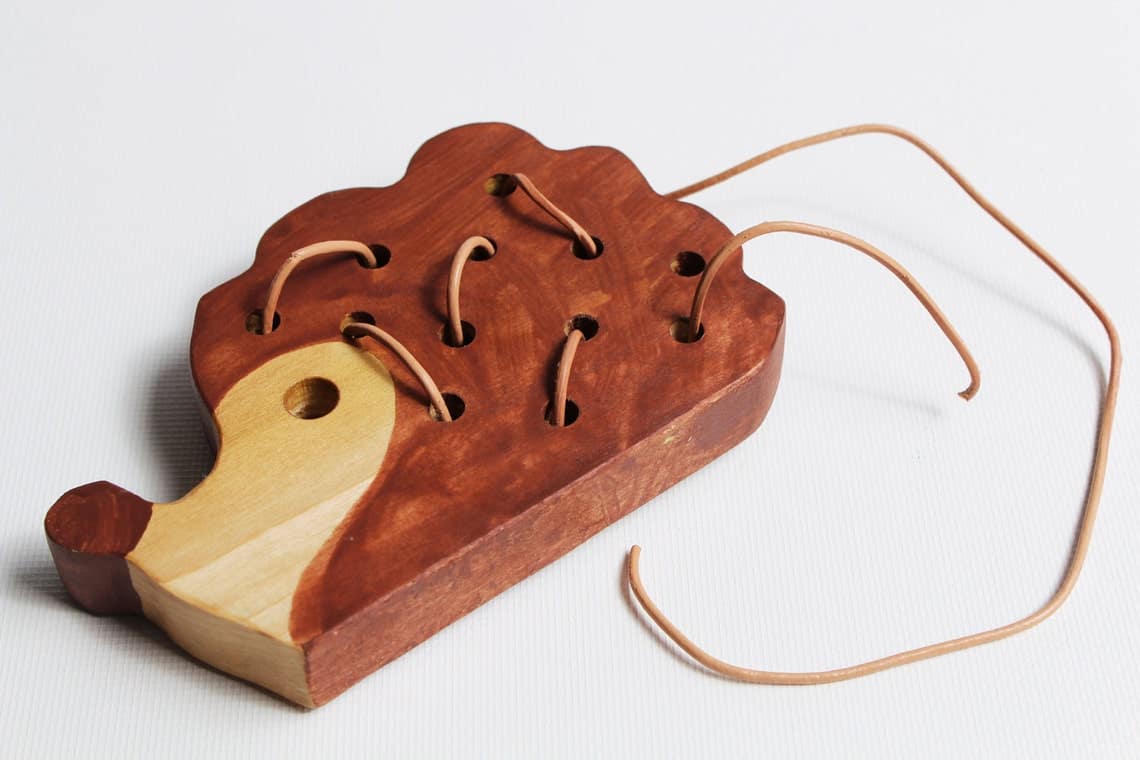
This toy is completely handmade, from the cut and shape to the manual paint. It boosts kids’ focus, fine motor skills, and concentration due to its lace that must be inserted into its various holes. It will help your child to create different patterns which further develop one’s critical thinking and problem-solving abilities.
This wooden hedgehog is another wonderful Montessori item. I love to see how simple wooden toys are making their comeback in full force after the era of toxic colored plastic toys. The materials are organic and the paint is kid-safe and non-toxic.
Toys for Bigger Children (5 to 8 Years Old)
Natural Wood Lacing Beads

If you want to improve your child’s dexterity, you should consider offering him or her this set of wooden beads that can be laced together. Fine motor skills are also boosted during playtime with this toy.
These wood lacing beads come in various shapes, sizes, and colors which will enable your little one to broaden pattern recognition. So, let the exploration begin!
Wooden Puzzle
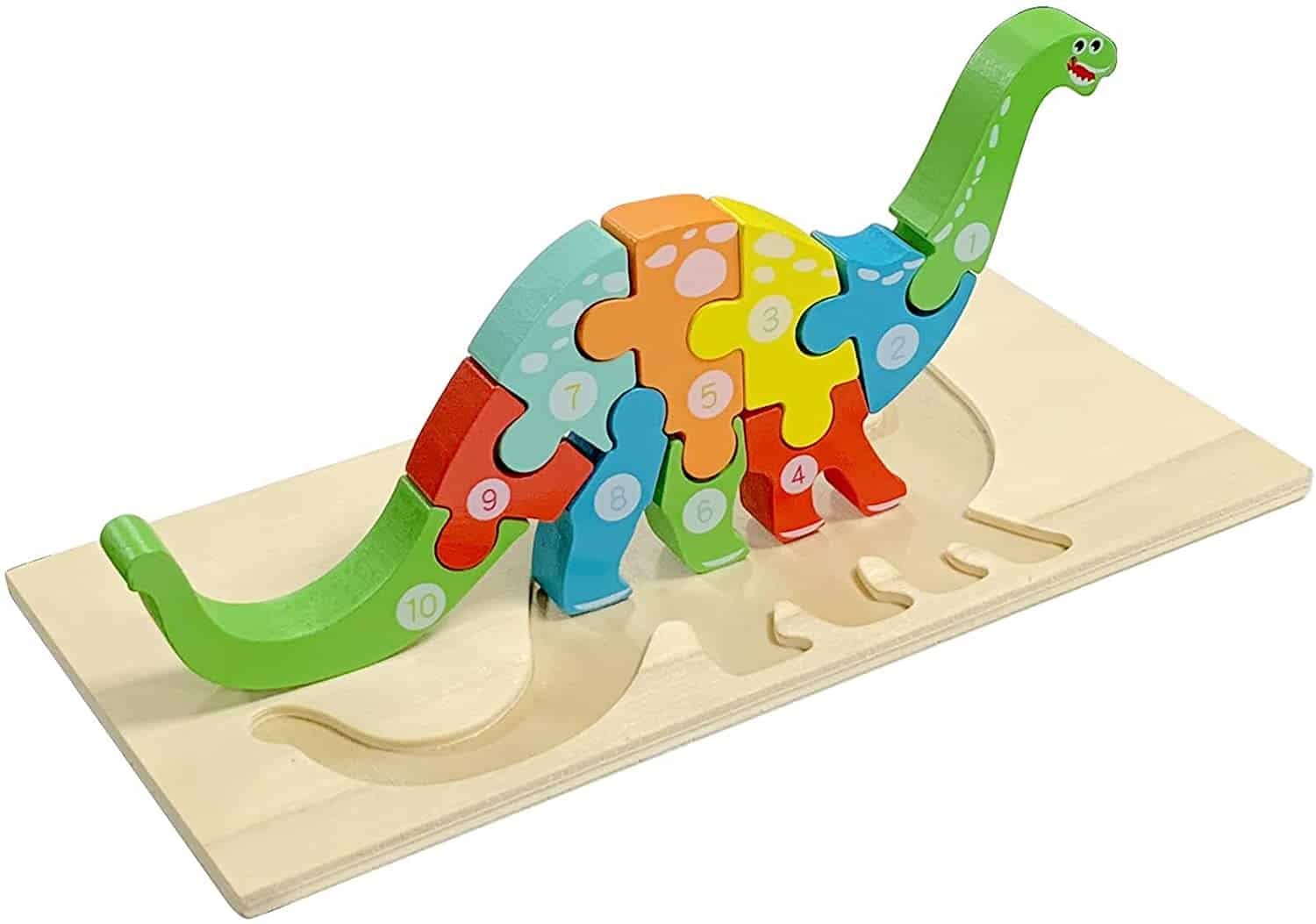
I love wooden puzzles. They’re great for older kids. There are so many of them on the market which means you’ll have to think about your child’s age, abilities, and preferences when searching for one that he or she will love playing with.
Easier puzzles are fun because they can be completed quickly, whereas more challenging alternatives can engage the whole family if you think about it as a DIY project.
Age Appropriate Toys Guide – How to Buy Safe Toys
The type of toy you want to buy, whether it’s something basic made of wood or a tech-savvy kid-friendly gadget, should be both safe and age-appropriate. Every single year, there are thousands of toy and play-related injuries among children in the US. Still, as long as you follow the guidelines that I’ve listed below, you will be able to keep your little one happy, safe, and sound.
a. Check the Warning Labels
- Most toys come with some sort of warning label that features useful information regarding that specific toy and its safety level;
- The toy’s label should also show details about the age recommendation. I’ve seen this info on all the packages of all the toys I’ve been purchasing for my two nieces. They’re both under the age of three years old, so I keep that in mind when looking for age-appropriate toys for them;
- Search for additional safety concerns such as flammability, toxic materials, etc. I’ve recently bought a plush teddy bear for the 5-year-old daughter of one of my friends, and, on its label, it was written that can be a choking hazard for small kids.
b. Prioritize Your Kid’s Safety
- If a toy comes with safety equipment, you should totally buy that, too. The most common example that comes to mind is buying a helmet when you’re offering your child his or her first bicycle. I remember my father buying me my first rollerskates that also came with a helmet and protection gear for my elbows and knees, but I constantly refused to wear them because they weren’t very comfy. Yet, my mother was always telling me to wear them every time I went out wearing the skates;
- Keep an eye for all your child’s toys, new and old ones, to see if any of them show signs of tear, wear, or damage. If they do, get rid of them as soon as possible;
- The toy’s size should match the child’s age. For instance, very small toys can be swallowed by babies, whereas very large toys could become a suffocation hazard.
c. Keep It Simple
- Before buying a new toy for your little one, you must consider these things: his or her interests, knowledge, awareness, and skill level;
- Both storybooks and building blocks are fun and entertaining but they’re also educational. I am always trying to find toys that have both of these features;
- One toy isn’t suited for all kids, even when they’re the same age. So, make sure to browse several product reviews and do your online research before going to the toy store and actually buying that toy.
Extra Tip! Always remember to read all the safety reviews published online in your search for safety details. Also, verify all the possible toy recalls.
Additional Tips Linked to Your Child’s Playtime
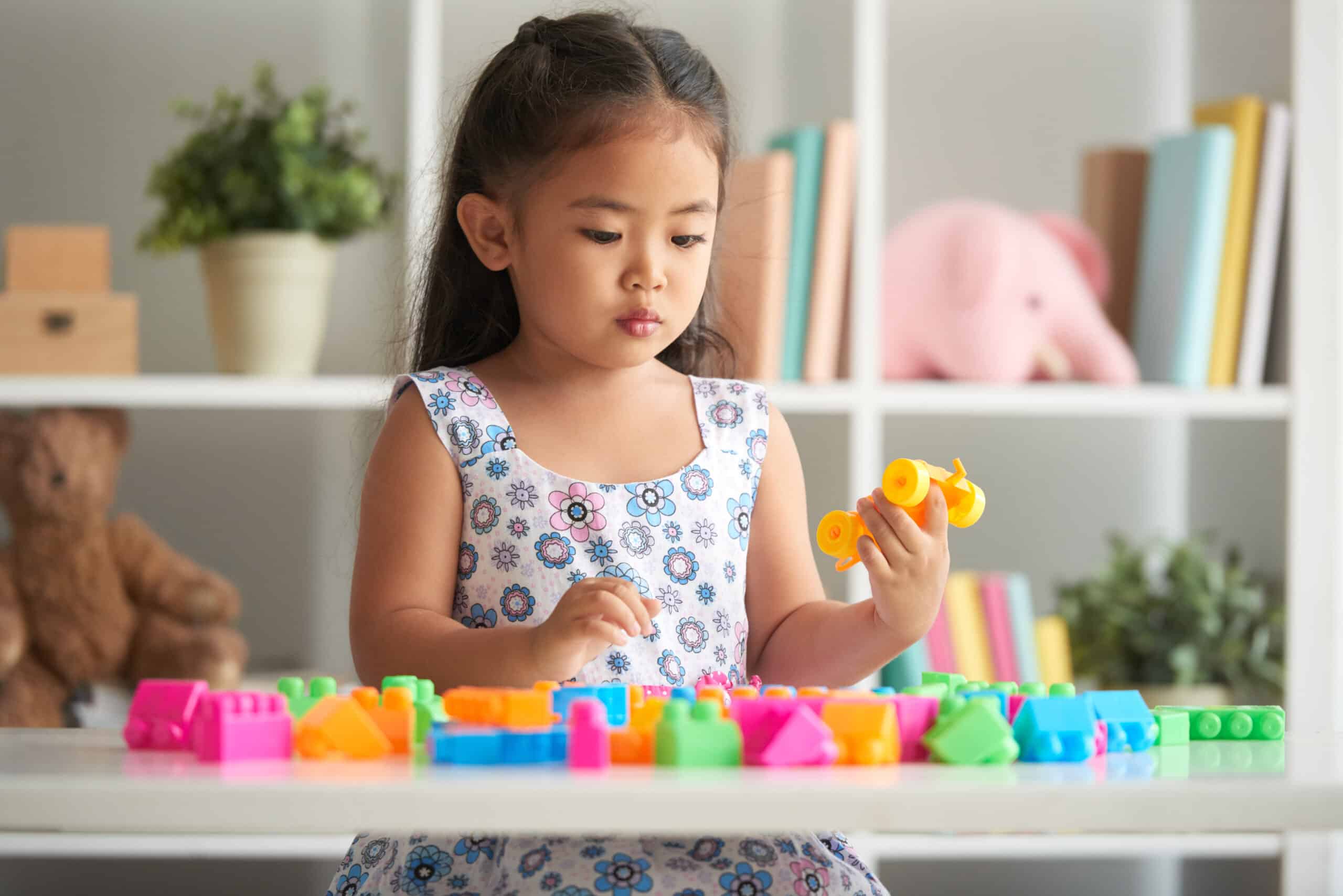
Keep it simple
Focus on buying simple toys that will let your child use his or her imagination. Too complex toys won’t allow that kind of skill development;
Offer only a couple of toys at a time to your little one
Don’t take them all out at once, although your little one might ask for all of them, and we know how inundated kids are these days with a wide range of toys. More and more parents can afford them and they want to spoil their children as a way of showing their love. I totally get that, I do, but displaying all of them might confuse children and they won’t know what to focus on first. One effective way is to give them to your child by rotation. Rotating toys will also help you surprise kids when they see those toys again and they won’t get bored as quickly;
Establish limits when it comes to electronic toys –
We must admit that we all live in a digitalized era and we cannot keep our kids away from gadgets for too long. But, what we can do is set time limits. Otherwise, too much time spent in front of screens might negatively impact your child’s attention span, communication and social skills, and his or her language development.
Age Appropriate Toys Guide – FAQs
Question: How Do I Know If a Toy Is Suitable for My Child?
Answer: You must read the label or the info that’s written on the package to find out if the toy is made with safe materials and whether or not it’s suitable for your child’s age. Your buying decision can also rely on online websites such as the one of the CPSC or other dedicated organizations where you’ll find more insights regarding the ideal choice when it comes to toys. Remember your kid’s age, personality, preferences, hobbies or interests, behavior, temperament, and habits.
Question: Why Should I Buy Age-Appropriate Toys for My Kids?
Answer: Playing with certain toys targets specific skills in a child. That’s why is very important to purchase only those toys that suit the age of your kid. At the same time, you shouldn’t worry about this too much, since many toys are good for kids of all ages, as long as they’re child-safe and non-toxic. Nowadays, all packages should feature the age recommendation.
Question: Is Playing with Toys Help the Development of My Child?
Answer: Yes, specially created toys that are fun but also educational can help your child develop his or her cognitive skills, motor abilities, critical thinking, problem-solving skills, and many others. Certain toys and playtime activities will even teach children conflict resolution tactics, empathy, generosity, and social skills. Numerous other toys are focused on boosting your kid’s creativity and imagination.
Age Appropriate Toys Guide – Bottom Line
Toys are like gold for children. I remember how much I was asking for a Barbie doll or a plush puppy I’ve seen at a store. So much that my mother would normally give up and buy those for me, despite the dozens of toys I already had at home. When it comes to kids and their toys, less is more has no value, whatsoever.
But, remember this: a toy might help your child to develop new skills, but you, as his or her parent, are the one who can support and nurture that growth.
Find more age-appropriate toys guides by checking these links below:
